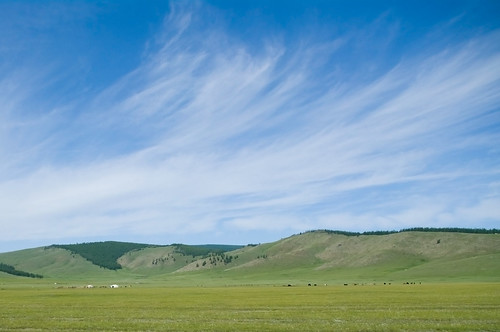
Mongolia
[Note: For the full picture set, see here]
Needing a break from humid, crowded Seoul, Sara and I took a vacation to cool, sparsely populated Mongolia. We went on a guided tour and chose to go to Lake Muren in Northern Mongolia. It is a large country, so there are many tour options – most have you drive hundreds of kilometers a day. We chose the lake since we wanted to just go somewhere beautiful and just relax.
We flew in to Beijing from Seoul and I got pulled aside after going through the thermal imager so they could take my temperature. I was worried, since China is notorious for ruining people's vacations right now with forced quarantines. Nobody spoke English and it was a little strange, but my temperature (36.2 C or 97.2 F) didn't cause too much concern (I always run cold), so they let me on my way.
We got our connecting ticket at the appropriately named connecting flights desk (my worries about not being able to find it were unfounded) and a woman from the desk led us around the terminal to get to the connecting flight. She took us through five security checkpoints and then put us on a bus and walked away. We were the only passengers on the bus and we were driven literally over the tarmac - we had to stop for a plane taking off. Being on the tarmac seemed surreal and the bus had a tv that had the X-Files in English playing - it didn't help. Especially since it was a “creepy little possessed girl” episode. We then went through another two security checkpoints and into our terminal. There were no problems at any point – it was just strange... somehow very communist.
The terminal we went to was very modern – from the drive I had assumed we were going to an ancient unused terminal. Lots of people were there - mostly Mongolians. The departure lounge we were in had two planes: one bound for Ulaan Baatar and one for Addis Addiba. It was striking to see people talking to one another – you could tell people were strangers and just making conversation. This is something you never see in Seoul, where strangers do their best (which is pretty good) to ignore each other.
Our flight was a little bumpy (Sara would tell you it was horrifying, but I was once on a two engine plane and one engine failed, so a lot less gets to me) and we landed in Ulaan Baatar with no problem. A very small woman was waiting with our names on a piece of paper and took us to a van, a very old Soviet vehicle. The first thing we noticed when we stepped outside of the terminal was the smell of fresh cut grass. It had been a long time. We shared the van with a couple from the south of South Korea (Pusan) – an American and a Canadian. They have been here for several years and said that Pusan is much more relaxed than Seoul. I wonder sometimes how our South Korean experience would be if Sara and I were in a different city… would we have better things to say?
Anyway, we got to the hostel after a 30 minute drive through Ulaan Baatar. Mongolia used to be a Soviet satellite, so all the buildings are blocky and cement and most are decrepit. Everywhere there is graffiti, dust, garbage and terrible roads. Raw is a good word to describe it – the city felt way more "real" than Seoul. Seoul is so superficial - people don't interact with each other. Everyone always has somewhere to go and they are going there in a hurry. We saw Mongolians just sitting around, hanging out. Casual.
We got our room in Idre’s Guest House (think hostel) and settled in for the night. Not the nicest, but our room was private and had its own bathroom. No soap or toilet paper - glad we brought our own. (You also don't flush toilet paper in Mongolia - you put it in a trashcan.) The next morning we had a few hours before our guide picked us up and we wandered around looking for better food than the one fried egg white we were served as breakfast at the guest house.
Most stores didn't open for a while and then they didn't open on time. Once we got in, there were a lot of Korean foods for sale - familiar brands. Mongolia doesn't make much, so most things are imported, usually from China, Russia or Korea. Later on, we found out that there are often shortages of consumer goods – at restaurants you can't get most things on the menu. We got some cheese for Sara and bread for me and wandered around, looking at the decrepit buildings. People were friendly enough - not overly friendly, but mildly curious and polite. You could call it "just right".
Mongolians write their language with the Cyrillic alphabet, so I could read a lot of signs, but the language itself is very different from Russian. Some borrowed words I got, but most I had no clue. Spoken Mongolian is a strange language. I wouldn't call it attractive, but it seems very utilitarian. I think it evolved so that they could communicate easily across great distances. It has many throaty noises x, ch, ss. People were very quiet, but they could understand each other quite easily. "Yes" is a noisy inhale with your mouth in an "o" position. "No" is a noisy inhale with your mouth in an "iy" position.
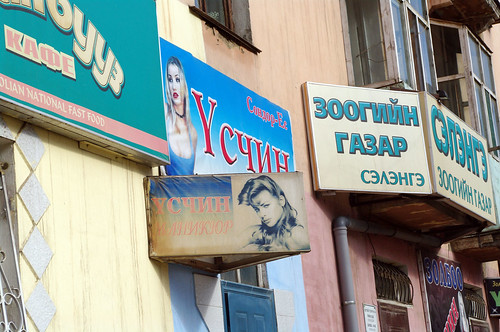
Hair Salons
Anyway, our guide picked us up and drove us to a few banks to try to get cash - the money that I had exchanged went towards paying the hostel, since the person on duty couldn't figure out the credit card machine. He turned out to not be our guide, but a driver, and drove us to the airport. In Mongolia there is no regulation for which side of the car the steering wheel is on – you take what you can get. They drive on the right side of the road, but traffic rules seem to be taken as suggestions, not law. At one point we saw the traffic police driving around in marked van yelling over his loudspeaker at anyone who was doing anything illegal and driving on. He yelled a lot.
We had a short flight from Ulaan Baatar to Muren, an hour and a half northwest. It was beautiful to look out the window - the landscape is almost bare of civilization. We came during the green part of the year, so it was very lush looking. There are no paved roads outside of towns, just a network of dirt roads. When a road becomes too rutted, people move off to the side of it and create new tracks. No rules against driving off the trail.
We flew over gers (yurts) here and there and watched herds of animals running. Everything was wild. Rivers, mountains, beautiful hills. The animals are all domesticated, but there are almost no fences.
We landed and our guide and driver met us - the guide spoke very good English, the driver none at all. Gamba was the guide's name - a rather portly Mongolian. As the nomadic lifestyle has turned urban, the diet has not changed. Obesity is a problem and things happened here just like they did in the Midwest. Walking around and doing farm work all day takes a lot of energy. City life does not.
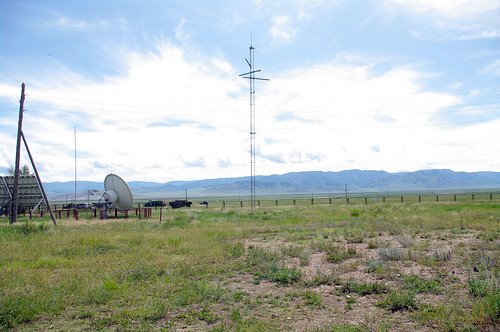
The view from the Muren Airport
Gamba was knowledgeable about Mongolian culture and customs, but annoying since he didn't like many ethnic groups. The Chinese, Russians, Japanese, Koreans and New Zealanders were all on his bad list and he had no problem with sharing this. He also loved Western rock music like Guns ‘n Roses and came up with some pretty random music quotes.
He took us to a restaurant in Muren and we had some beef and noodles. Gamba insisted on ordering for me and wouldn’t listen to what I wanted, ordering me a carrot and cheese dish instead of a side salad. The whole meal was decent – the spices reminded me of Chinese food. Then I remembered that we were very close to China.
After lunch we set out to the lake. The driver drove a Toyota land cruiser and the paved road ended at the airport. He drove fast when he could, but it was mainly very slow going. The countryside is beautiful - very empty. We saw sheep, goats, cows, yaks and horses, all running free. Very few people and only a few other cars.

Our ride - a Toyota Land Cruiser that only got two flats on our 150 mile trip

The views were spectacular. You can see people's gers and herds down by the river

Roads were "suggested" at worst and graded at best
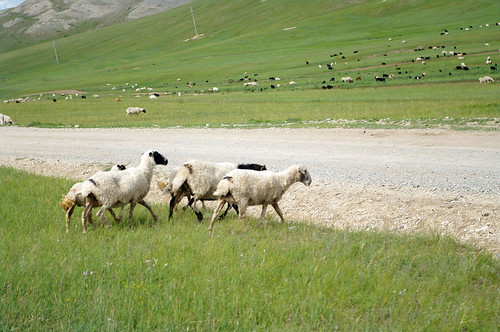
Some sheep running from our vehicle
Every once in a while you would see just a person or two walking somewhere... it looked strange because you couldn't see where they had started or where they were going to. All the animals we saw were grazing or running away from us. It took us about three hours to travel the 60 miles to the lake. It took another 30 minutes to travel the last half mile to our camp.
We were shown our ger (yurt) and then we unpacked. Gers are made of felt stretched around a wooden frame. We could stand up in the middle area, but you definitely have to duck to get in. The ger had a stove in the middle and three beds - one opposite the door, one to the right, and one to the left. There was a small dresser and a small table. Gers are meant to be moved, so things are pretty sparse. It is the tradition to leave your shoes on inside. There was one electric light – electricity is available for a few hours at night. Bathrooms and showers were located in a nearby building – how water only was available at certain times as well. It all reminded me of summer camp!
The only window was at the top middle of the ger - there was some plastic covering the top area around the smokestack. Traditionally this hole was left open except during weather, so it let fresh air in. Also, the bottom edge of the ger was mostly uncovered - it was rolled up a bit to let in air (and the occasional insect). There were some bees and horseflies that wandered in, but not too many. Around the lake there were many, many flies. Free roaming yaks, goats, cows, sheep and horses makes for lots of shit and that means flies.
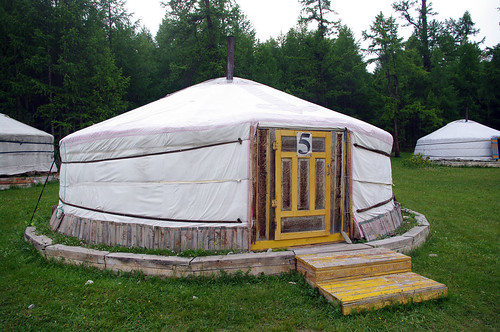
Ger #5
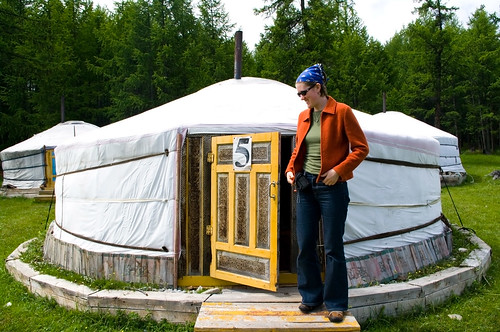
Sara providing some perspective

The textures of the ger: wood and felt

The textures of the ger door
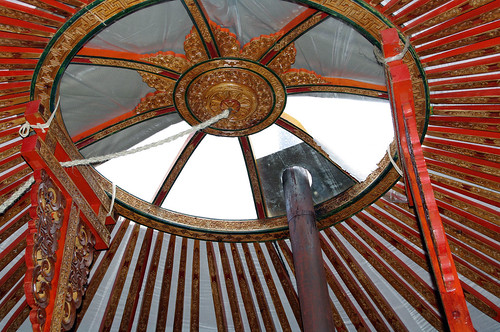
The inside of our ger showing posts, beams and smokestack.
We checked out the lake and surrounding area for the rest of the day and had the second of what turned out to be many beef meals. I also convinced Gamba that I wanted to try that famous Mongolian drink – fermented mare’s milk – also known as airag or kumis. Milking a mare is a two-person job. One person holds the horse and the other sits directly behind the horse and reaches around to milk it (why was that sentence so hard to write?). Besides extending its shelf life, fermenting the milk also takes away its powerful laxative properties. The descriptions I’d read of the milk made it sound horrible, but I didn’t mind it at all – it reminded me of yoghurt water. Not delicious, mind you, but definitely palatable.
The next day we went to visit a nomadic family - an hour’s drive away, or 20 minutes as the crow flies. The family set up camp in an "accessible" area by the lake and brought their reindeer for tourists to take pictures of (for a fee). It felt a bit like an Indian reservation and made Sara and me uncomfortable. Our guide as well. We went down to the lake and spent time there instead, taking pictures, and ate some lunch (beef). Suddenly a rainstorm came over the mountains and we drove back to the ger.
Sara and I got warm in our ger and went out for a walk after the weather passed. The next day we went for a boat ride to a spit in the middle of the lake. There were many other tourists there, but it was very beautiful. There were a few shamanistic shrines - lots of torn blue cloth, money and vodka offerings. You see these shrine spots all over - torn blue fabric wrapped around trees and rocks here and there. Blue is a sacred color for the Mongolians - the limitless sky.
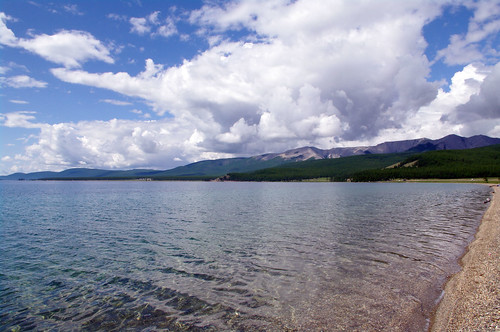
A view from the lake shore
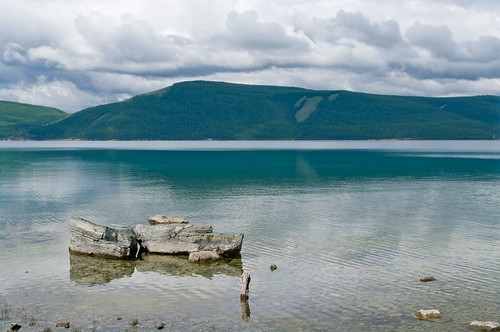
Another view of the lake
We wandered around, then went back to the camp and hung out and then did some more wandering. Beef again for lunch, but there was a special treat for dinner: goat. Not having an oven, they cooked the goat the traditional way, by heating up some rocks (pillow basalt) in a fire and sticking them in a bag (made of the goat) with the dressed goat meat inside. They handed us the rocks at first – still very hot – which I believe is a tradition. The goat was delicious – I’d definitely eat it again.
The next day we went for a horse ride: Sara, the guide, myself and the horse owner, Ot. His real name is five syllables long, so we kept it at Ot. It was my first time on a horse, so I was on a lead, but it wasn’t nearly as scary as I thought it would be. My horse was very gassy though. We rode up to a shrine that looked over the nearest town – a beautiful view. There were some other Mongolians up there and people just chatted with each other. Again, it was refreshing to see strangers talking to each other. When hiking, many Koreans listen to the radio or watch their portable tvs.
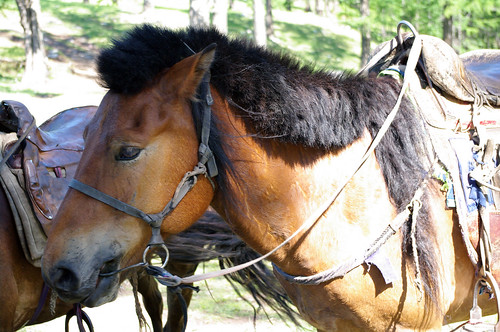
The gassy horse I rode
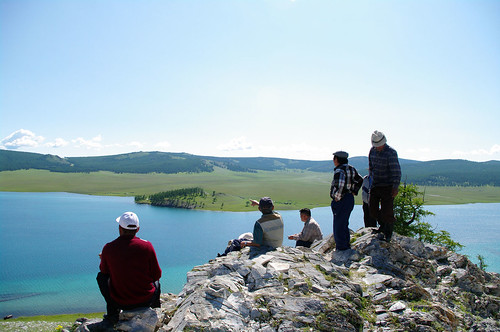
Mongolians admiring the view

The shrine and the lake
We saddled back up and rode to a group of tourists who were being led to their campsite on horseback. Some of them had slow horses so Ot rode around to the back of them and encouraged them on. I was on lead, so I followed him, of course. I talked a little bit to Ot in Russian - neither of us spoke it well, but it was fun to be able to communicate and he invited us to his ger for tea.
We rode up to his home area and he hollered for his son to come out and help with the horses. He has 20 or 30 horses and lives in an area with one other family and their ger. As far as I can tell, there is no land ownership, so he has squatter's rights. His ger was very basic - it turns out that our tourist ger is quite fancy with its carvings and stout beams.
His wife made us some “tea” (hot salted milk) and served some fresh made bread and yak butter. Yak butter is absolutely amazing. Delicious. Their ger was kind of dilapidated, but it was good to see how herders or nomads actually live. Every winter they move their ger to the closest town (population 2,000) so his kids can go to school. His horses wander around freely, although they are usually hobbled.
Nearby, all the herds of goats and sheep we saw had a child looking after them. Time and time again, we saw children just hanging out in the middle of nowhere. It was really refreshing to see kids able to wander without fear. The kids in the countryside were quite healthy looking, although we saw street children in Ulaan Baatar who were filthy and impoverished.
Eventually we got back on the horses and rode the rest of the way back to our ger camp. We caught up with the slow group and encouraged them on again, gave up and cantered home. I was shocked at the pick-up horses have… quite some acceleration! Up to that point I had done pretty well at not clinging on to the saddle with my free hand, but damn that horse was going fast.
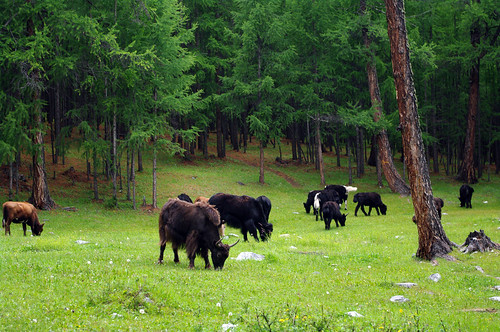
A forest herd of yaks and cows
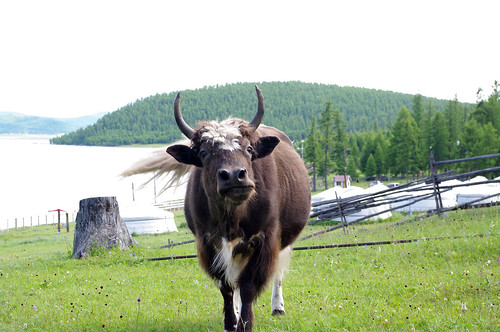
A friendly cow (yak?)
After that we wandered to take more pictures. The sky started clouding over and we hurried back. There was an intense lightning storm and I got some great photos. The storm left mammatus clouds – I’ve always wanted to see them in person. That night there was an even bigger lightning storm - several flashes per second for a half hour. All the beef that I had been eating caught up to me and I wasn’t going to be sleeping anyway, so it was a nice distraction.
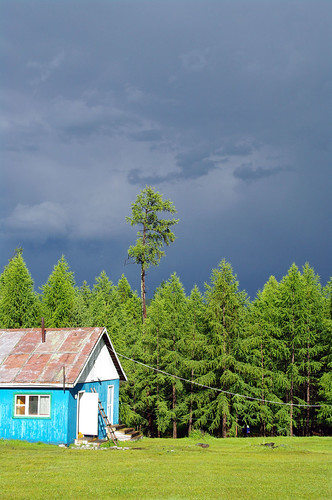
The bathhouse after the storm
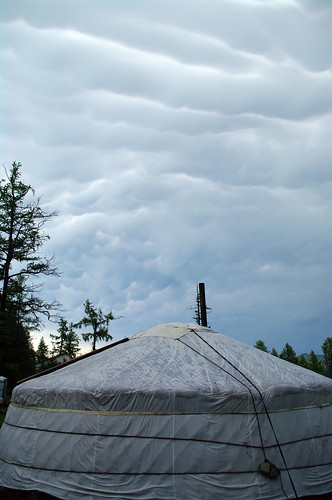
Mammatus clouds over our ger
The next day we drove back and it was quite bumpy, giving me a fairly debilitating headache. Before taking us to the airport, we went to see the deer stones – old megaliths with carved deer on them.
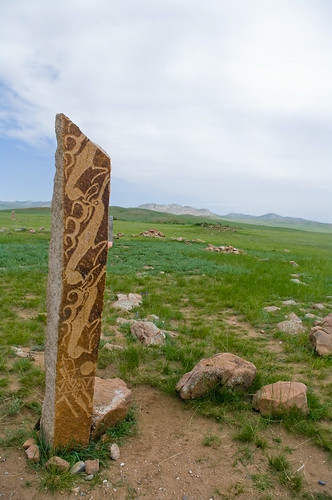
Deer stones
We flew back to Ulaan Baatar and Sara got me some ibuprofen. I took a short nap and felt a million times better. I got up and we went out and ate Cuban food and explored the dirty city. The foreign food in Mongolia is much better than the foreign food in Seoul.
Every city in Mongolia has a land policy where anyone is entitled to a little land to put their ger and animals on. People coming from the country live all around the edges of cities in these ger camps. Walking around, we saw street kids and Porsches, prostitutes and men in suits. There were poor Russians and rich Mongolians, as well as rich Russians and poor Mongolians – I believe this led to a sort of harmony. You also saw interracial couples, with either gender coming from either ethnic group. Due to the traditional Confucian culture, in Korea interracial couples are almost exclusively Korean women with Western men. Not many Western women will put up with the domineering Korean male archetype: think of 1950’s US man.
We spent one full day in Ulaan Baatar, wandering around and at the natural history museum. I think the Soviets were the last people to put any money into it – very decrepit, yellowing and peeling exhibit descriptions, not up-to-date information, horrible taxidermy, etc. They had amazing fossils though – the Gobi Desert is rich with them. My two favorites were of course the famous Velociraptor fighting a Protoceratops; and the arms of a Deinocherious – a dinosaur with eight foot long arms and ten inch long claws. Yikes! The museum was also very firm in their statements about evolution – I had had no idea how the Soviets presented the topic; not surprisingly, it was with an iron fist.
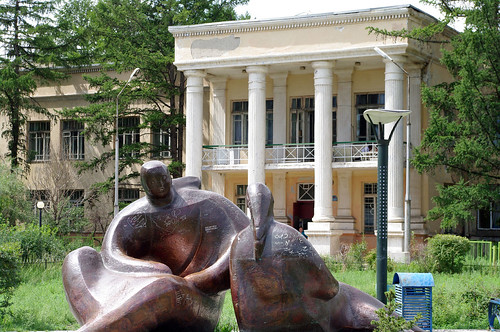
Statues and buildings - all decrepit

BD's Mongolian Barbeque
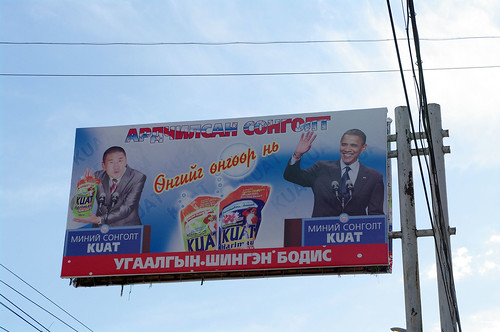
Creative product endorsement
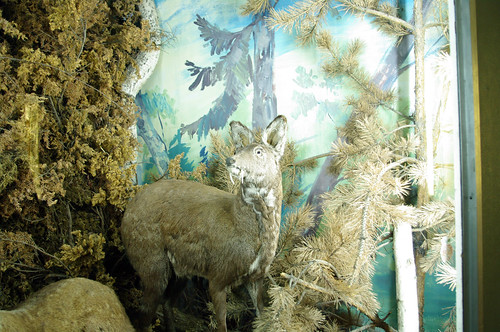
Poorly presented musk deer
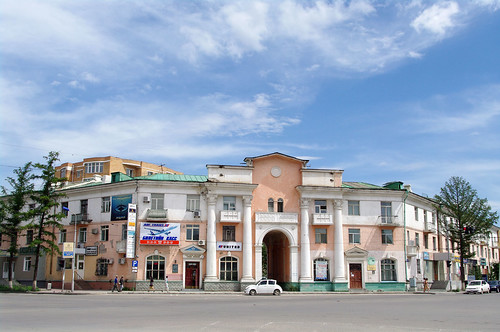
Random Havana-esque building
Seven days and 620 photographs later, Sara and I left early in the morning, feeling spiritually refreshed. I am so happy to know that there are places like Mongolia left in the world – raw, natural, and open. Our drive to the airport was courtesy of some guy – apparently many drivers are opportune taxi drivers. We got one last look at Ulaan Baatar – abandoned skeletal apartment blocks with a few ger squatters, new apartment blocks going up, tired prostitutes, and people resting under billboards while their sheep grazed nearby.
Sasha

1 comment:
very accurate view of Mongolia. I've also been there 4 times. All in different seasons. I also stayed in Ger's every time but always in Terelj national park, close to Ulaanbaatar. Thanks for sharing.
Post a Comment